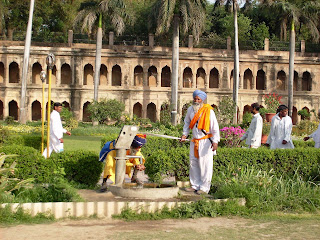After a delicious dinner of a South Indian favorite of mine, uttapum with coconut chutney, at Dipika & Bharat’s, I was off to see another cousin, Sucheta (from my father’s side) where I stayed the night. Today we went to visit the hospital where I was born, then to the school where my cousin (Sucheta’s brother) Dharmesh goes. Sucheta drove me around on her scooter, and I apparently tried to get on before she was ready for me to, and we both fell hard on the concrete pavement, along with the scooter. My right side is very sore, but we were lucky it didn’t happen while we were driving in traffic. An interesting side note: a lot of women cover their faces & heads with a scarf when they ride scooters, to protect themselves from the pollution & the heat, which is intense in the afternoons.
Sucheta dropped me off at yet another cousin’s house, Suresh (on my mother’s side) where Suresh’s sister Bhavana & her husband came to see me. Then in the evening, it was off to Dipika’s sister Aruna’s house in the outlying town of Naroda. We had a huge dinner there & watched cricket on TV.
Tomorrow we’ll go see Dipika & Bharat’s farmhouse, then it will be time to pack up & head to the airport for my 9 PM flight (Ahmedabad to Mumbai to Amserdam to NYC to Rochester, which is about 20 hours of flying time, not counting layovers). It’s been wonderful seeing my family, although there wasn’t enough time to see everyone. Looking forward to getting home. It will seem cold compared to the blistering heat here.


Sucheta & I by her scooter (the one we fell off of)


































